Sections
Visuality plays a remarkable role in the Conferment Ceremony. In fact, the Conferment is not only a festive ceremony, but also a play of its own kind. It concretizes the transition from an undergraduate to a Master or from a graduate student to Ph.D. The play involves not only the roles, lines and stage, but also the costumes. Dressing according to the role creates cohesion within one’s own group, while it also helps in telling the different groups apart. Following the dress code and etiquette creates a sense of solidarity and a warm atmosphere. The dress code also makes the several choreographed elements of The Conferment Ceremony visually impressive, and without the consistent dress code of black and white this graphic play would not be possible. The dress code in the Conferment Ceremony creates an essential part of the framework for a celebration that each can make their own.
For these reasons, we expect the promovendi, companions and guests to dress according to the dress code. This applies especially to the Conferment Act and the Conferment Ball.
The division between Doctors and Masters in the Conferment Ceremony comes through the colours: the Masters wear white, and the Doctors wear black. On this page you can find the instructions regarding the specific dress codes for each event separately. There are separate instructions for the promovendi, their companions and for the guests. We have also collaborated with companies that sell and rent outfits suitable for the Conferment Ceremony – their offers can be found on a separate page. We also recommend visiting the Promootiot kierrättää Facebook group!
There are two options for the dress code: white tie or an evening gown (please see more detailed instructions for each option). Each promovendi has the right to choose the best suitable option for them. The chosen dress code (1 or 2) must be followed throughout the entire Conferment Ceremony, and combining the two options is not allowed. Please note that the chosen dress code will affect the groupings and the organizing of the dances in some events. The Conferment Committee (fil-promootio@helsinki.fi) is happy to answer possible questions about the dress code.
The doctoral hats are hand-made, and it is thus recommended to order the hat as early as possible before the Conferment Ceremony. Remember also to check the offer for the hats from our collaboration partners!
In the less formal events (i.e. Flora’s Day and the Conferment Excursion) the dress code is more flexible. The dress codes and instructions can be found from a separate section. There are also instructions for the use of state and academic awards, decorations and orders of merit and for the use of dress uniforms, as well as some general notions about the dress code. The dress codes are compulsory in each of the Conferment events. Information about the academic insignia can be found from its own page.
The best festivities are created by respecting the fellow celebrants. We have curated general directives that we wish everyone attending the Conferment Ceremony will follow. Please read the instructions carefully before the Conferment Ceremony!
Master promovendus
Choose either option 1 or 2 and dress according to this option throughout the entire Conferment Ceremony. You may not combine the two options.
The wreath-weaver – the companion of the Master promovendus – shall otherwise dress as a Master promovendus, but without the laurel wreath or the ring. A student cap may still be used on Flower’s Day and the Excursion.
Flower’s Day
Option 1: Finnish student cap and a light, but weather-appropriate spring outfit. For example, a dress or a skirt/pant suit. The colours can be chosen freely. The student cap is also worn indoors.
Option 2: Finnish student cap and a light, weather-appropriate spring outfit. For example, a (summer) suit or coordinates with a dress shirt and a tie. The colours can be chosen freely. The student cap is also worn indoors.
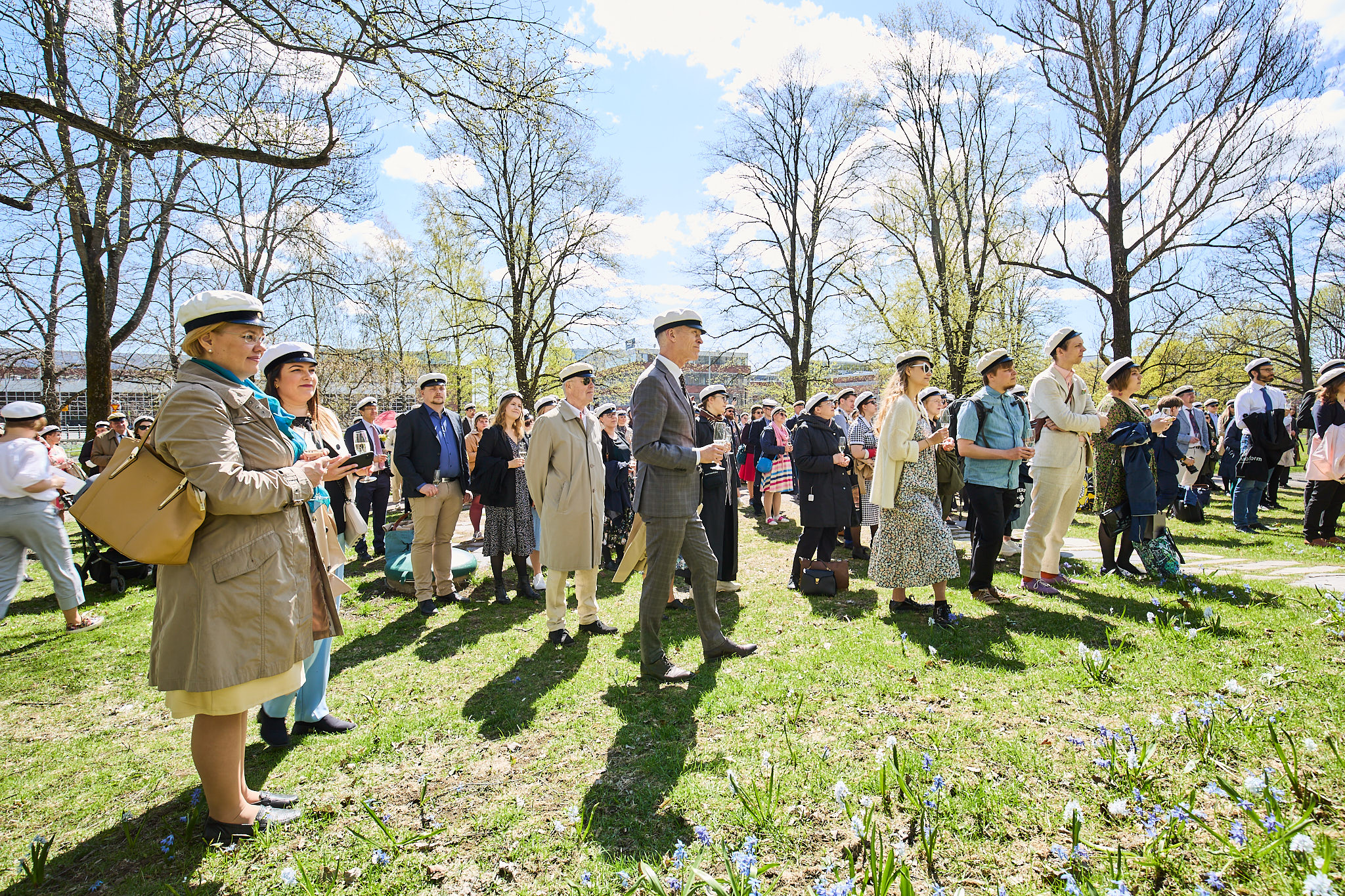
Wreath-Weaving Day
Please note that there is no time for changing clothes between the rehearsal and the dinner, so dress according to the evening’s dress code already for the rehearsal.
Option 1: Colourful, long evening gown. The dress must be full-length, and it cannot be black or white, however the decorations and patterns may include these colours. The openness of the dress is up to your choice. It is recommended to consider the nature of the event as well as the springtime when choosing the dress.
Option 2: Formal dress, also known as white ties. A dress suit includes a black tailcoat, black trousers, a dress shirt, a white waistcoat, a white bow tie, a white pocket square and white gloves.
The dress shirt has a starched stand-up collar and single cuffs. Ruffled or pleated shirts do not go together with a dress suit. The dress shirt buttons are of pearl or gold, black buttons are not according to the etiquette. The pocket square should be folded into a narrow TV fold.
Wrist watches are not used with a dress suit, and if using a pocket watch, the chains should not be too visible. Black patent-leather shoes are used with the dress suit. Socks ought to be black as well. The most suitable overcoat with a dress suit is a dark dress coat or a cloak. If using a scarf, it must be white.
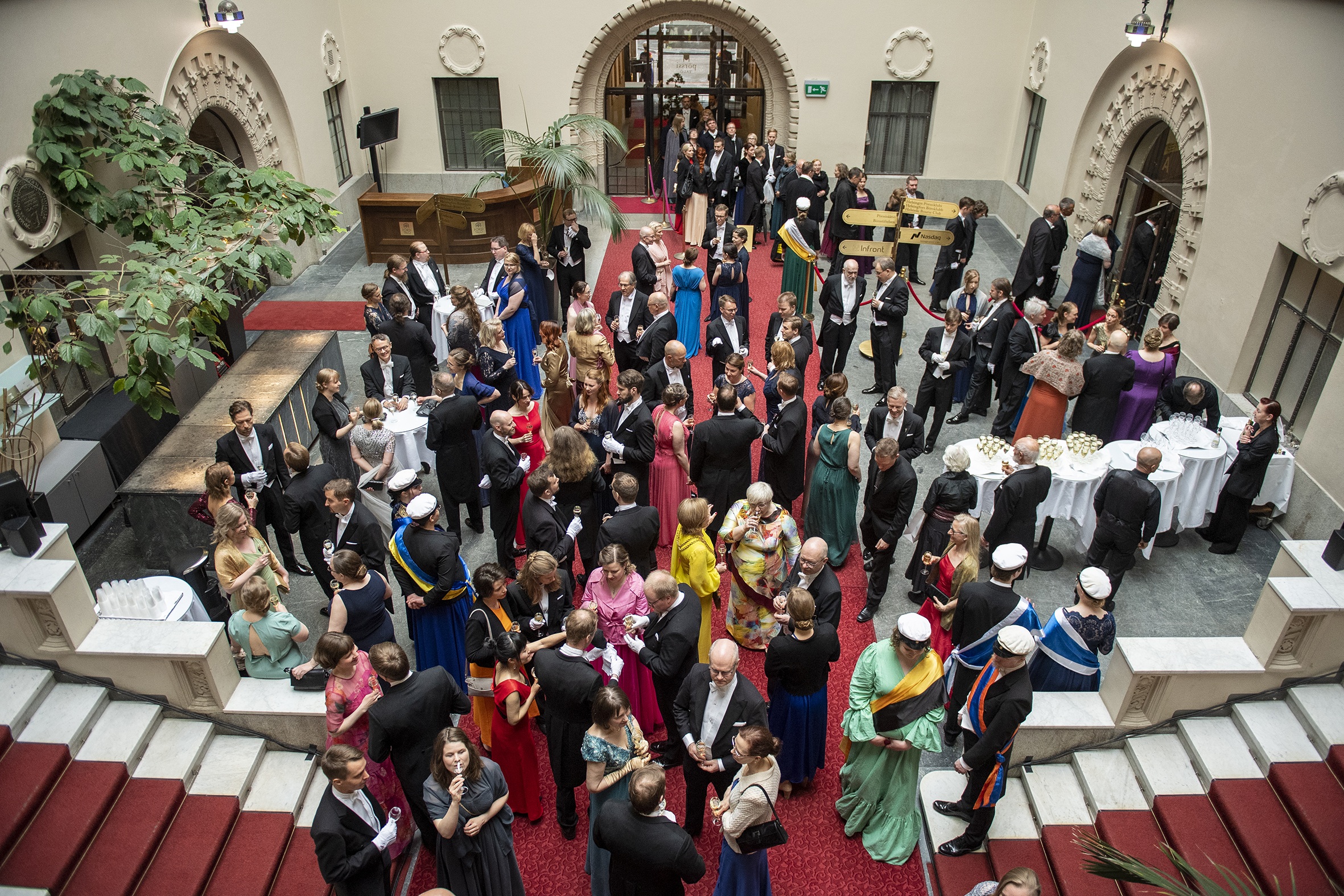
Conferment Act and Laudatio Solemnis
Option 1:The Conferment Act dress for a Master promovendus is completely white, full-length and covering. The dress should be simple and elegant. It must be pure white: “white” in the Conferment Ceremony is a shade that resembles that of a copying paper, and not for example natural or creamy white/ivory. Please pay attention to the shade as much as is reasonable.
A suitable material is, for example, wool muslin, Dupion-silk or thick satin. The fabric may have white embroidery and it may have a pattern woven into the design (e.g. damask). The material may not be see-through or embroidered with coloured or metallic thread, and the fabric may not have loose decorations, such as sequins.
The hem of a full-length dress covers the malleoli on the outer edge of the ankle. The dress should have full-length sleeves reaching up to the wrists and a neck-hugging, high O-neckline (and not boat- or V-neckline). You should be able to go up and down the stairs gracefully with the dress. Thus, we do not recommend a dress reaching all the way down to the floor or with a train. To maintain the elegance and simplicity, the dress needs to be slim. If a slit needs to be made to improve mobility, it should not be any longer than is necessary. It is recommended to make, or have the fold made using a Dior pleat.
White gloves covering the wrist and all fingers (leaving no skin visible) are used with the Conferment Act outfit. Suitable gloves are simple, undecorated and cover the back of the hand. The gloves must blend with the rest of the outfit and its shade, and they should not stand out e.g. with a more yellowish tone. Lace gloves are not suitable.
White shoes are used with the outfit. The shoes must be closed both from the tip and the heel – sandals are not festive enough for the Conferment Act. You may wear a small, discreet necklace and/or button earrings with the dress. To give the Master’s ring the spotlight it is recommended not to wear any other rings, except for a wedding ring, during the Conferment Act. A handbag or a clutch is not part of the Conferment Act outfit. Necessary small items can be hidden for example in a secret pocket sown inside the dress. Remember the laurel wreath.
Option 2: Formal dress. Like on the Wreath-Weaving Day, but with a black waistcoat (instead of white), and black, polished leather shoes with a thin sole as well as the laurel wreath and Master’s ring. Also remember white gloves. Note that a pocket square is not used with a black waistcoat.

Conferment Dinner and Ball
Option 1: The Conferment Act dress is also suitable for the Conferment Dinner and Ball, however with a more flexible dress code especially for the Ball. A neckline that is too wide and an open back should still be avoided. The dress should have sleeves; however, they can be shorter for the Conferment Dinner. The same dress as in the Conferment Act and Dinner may also be used during the Ball, or the dress can be changed into a more décolleté dress with a wider hem. The outfit still needs to be white. The Ball outfit includes gloves with a length depending on the length of the sleeves. A handbag or a clutch is permitted, but it has to match the dress. It is not, however, used during the dancing.
Also recall the laurel wreath and the Master’s ring.
Option 2: Formal dress. Similar outfit as on the sword-whetting day, but with a black waistcoat (instead of white), and black, polished leather shoes with a thin sole as well as the as well as the laurel wreath and the Master’s ring. Also remember white gloves. Note that a pocket square is not used with a black waistcoat.
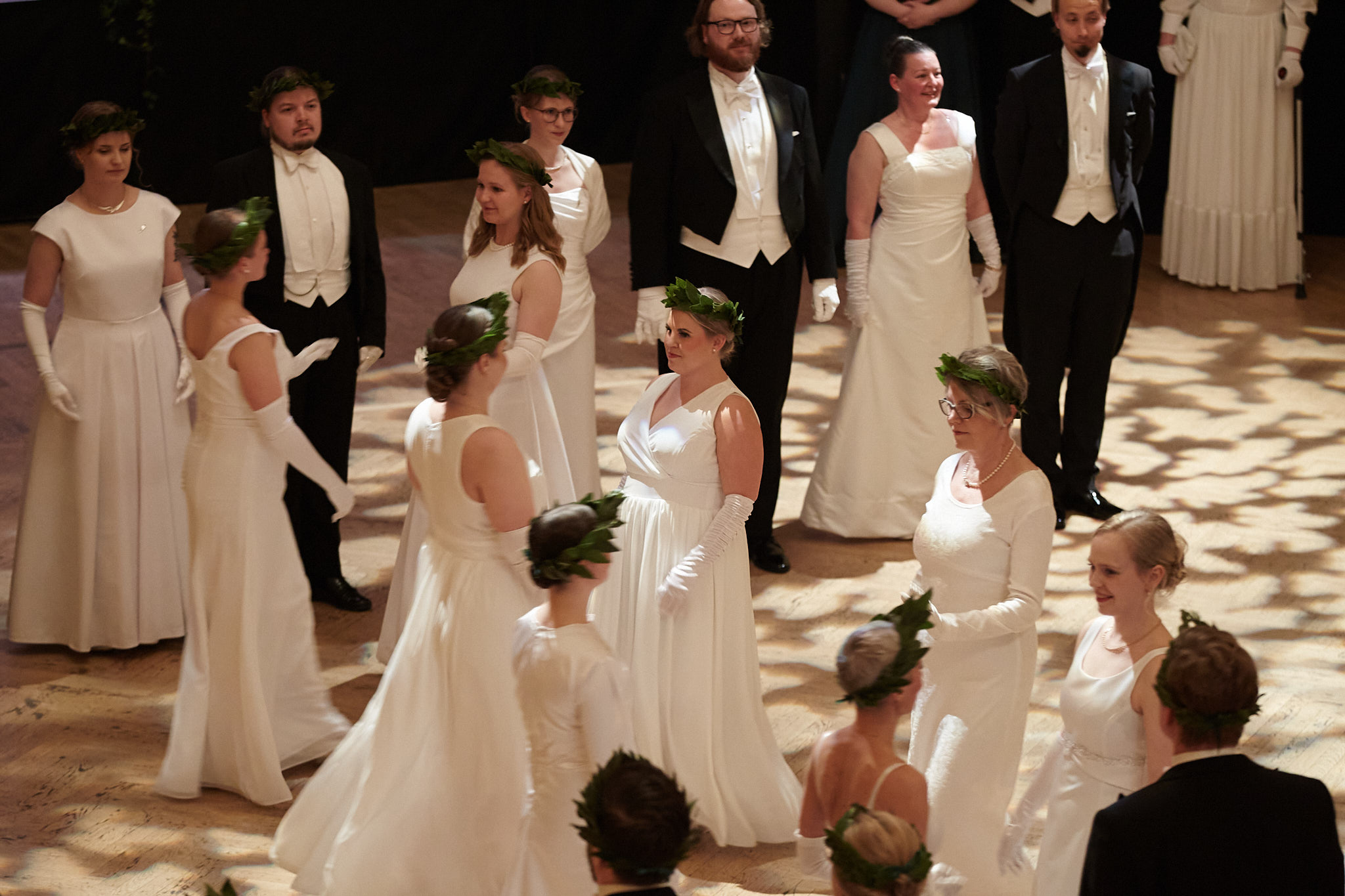
The Excursion
A Finnish student cap is used (if you have one) both indoors and outdoors during the Excursion, so the rest of the outfit should go together with the cap. The outfit should not be too sporty, and jeans or clothing with advertising are not suitable.
Option 1: Relaxed, weather-appropriate outfit. A suitable outfit for the Excursion is, for example, a comfortable but neat skirt or trousers and a cardigan.
Option 2: Relaxed, weather-appropriate outfit. A suitable outfit for the Excursion is, for example, corduroy or cotton trousers, a cardigan and a dress/collar. Coordinates are also suitable.

Doctor promovendus
Choose either option 1 or 2 and dress according to this option throughout the entire Conferment Ceremony. You may not combine the two options.
The sword-whetter – the companion of the Doctor promovendus – shall otherwise dress as a Doctor promovendus, but without the doctoral sword. If the sword-whetter owns a hat they may use it only after the act. A student cap (if one exists) may still be worn on Flower’s Day and the Excursion, and a doctoral hat (if one exists) whenever allowed for the promovendus.
Flower’s Day
Option 1: Finnish student cap and a light, but weather-appropriate spring outfit. For example, a dress or a skirt/pant suit. The colours can be chosen freely. The student cap is also worn indoors.
Option 2: Finnish student cap and a light, weather-appropriate spring outfit. For example, a (summer) suit or coordinates with a dress shirt and a tie. The colours can be chosen freely. The student cap is also worn indoors.

Sword-Whetting Day
Please note that there is no time for changing clothes between the rehearsal and the dinner, so dress according to the evening’s dress code already for the rehearsal. The doctoral hat and sword do not yet belong to the Sword-whetting Day’s dress code!
Option 1:
Colourful, long evening gown. The dress must be full-length, and it cannot be black or white, however the decorations and patterns may include these colours. The openness of the dress is up to your choice. It is recommended to consider the nature of the event as well as the springtime when choosing the dress.
Option 2:
Formal dress, also known as white ties. A dress suit includes a black tailcoat, black trousers, a dress shirt, a white waistcoat, a white bow tie, a white pocket square and white gloves.
The dress shirt has a starched stand-up collar and single cuffs. Ruffled or pleated shirts do not go together with a dress suit. The dress shirt buttons are of pearl or gold, black buttons are not according to the etiquette. The pocket square should be folded into a narrow TV fold.
Wrist watches are not used with a dress suit, and if using a pocket watch, the chains should not be too visible. Black patent-leather shoes are used with the dress suit. Socks ought to be black as well. The most suitable overcoat with a dress suit is a dark dress coat or a cloak. If using a scarf, it must be white.
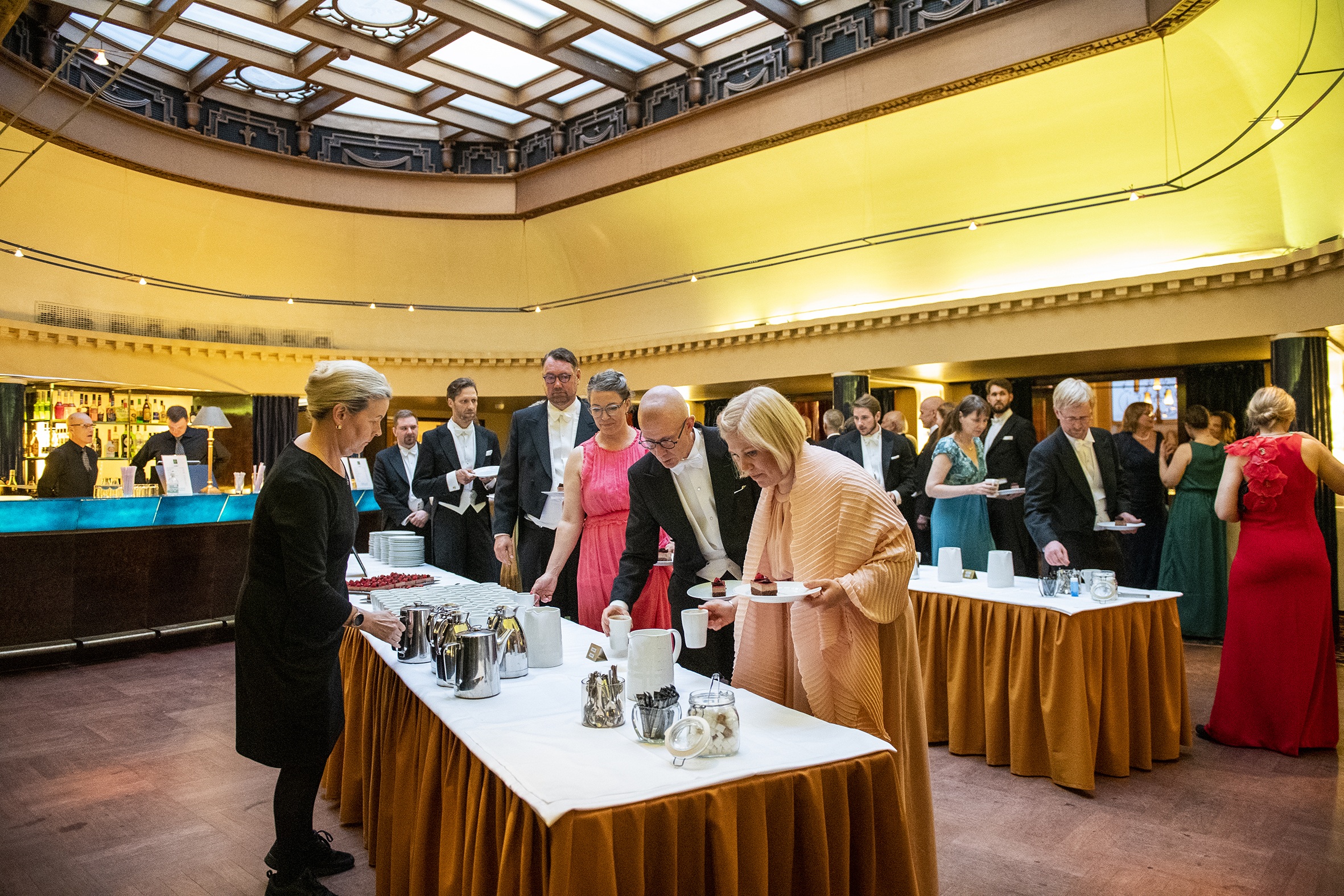
Conferment Act and Laudatio Solemnis
Option 1:
The Conferment Act dress for a Doctor promovendus is black, full-length and covering. The dress should be simple and elegant. The outfit includes black gloves and black shoes.
A suitable material is, for example, wool muslin, Dupion-silk or thick satin. The fabric may have black embroidery and it may have a pattern woven into the design (e.g. damask). The material may not be see-through or embroidered with coloured or metallic thread, and the fabric may not have loose decorations, such as sequins.
The hem of a full-length dress covers the malleoli on the outer edge of the ankle. The dress should have full-length sleeves reaching up to the wrists and a neck-hugging, high O-neckline (and not boat- or V-neckline). You should be able to go up and down the stairs gracefully with the dress. Thus, we do not recommend a dress reaching all the way down to the floor or with a train. To maintain the elegance and simplicity, the dress needs to be slim. If a slit needs to be made to improve mobility, it should not be any longer than is necessary. It is recommended to make, or have the fold made using a Dior pleat.
Black gloves covering the wrist and all fingers (leaving no skin visible) are used with the Conferment Act dress. Suitable gloves are simple, undecorated and cover the back of the hand. The gloves must blend with the rest of the outfit, and they should not stand out. Lace gloves are not suitable.
Black shoes are used with the outfit. The shoes must be closed both from the tip and the heel – sandals are not festive enough for the Conferment Act. You may wear a small, discreet necklace and/or button earrings with the dress. A handbag or a clutch is not part of the Conferment Act outfit. Necessary small items can be hidden for example in a secret pocket sewn inside the dress.
Do not forget the Doctor’s hat and sword.
Option 2:
Formal dress. Similar outfit as on the sword-whetting day, but with a black waistcoat (instead of white), and black, polished leather shoes with a thin sole as well as the Doctor’s hat and sword. Also remember white gloves. Note that a pocket square is not used with a black waistcoat.

Conferment Dinner and Ball
Option 1: The Conferment Act dress for a Doctor promovendus is also suitable for the Conferment Dinner and Ball, however with a more flexible dress code especially for the Ball. A neckline that is too wide and an open back should still be avoided. The dress should have sleeves; however, they can be shorter for the Conferment Dinner. The same dress as in the Conferment Act and Dinner may also be used during the Ball, or the dress can be changed into a more décolleté dress with a wider hem. The outfit still needs to be black. The Ball outfit includes gloves with a length depending on the length of the sleeves.
A handbag or a clutch is permitted, but it has to match the dress. It is not, however, used during the dancing. Also remember the Doctor’s hat and sword.
Option 2: Formal dress. Same as during the wreath-weaving day (with a white waistcoat). Also remember white gloves, and the Doctor’s hat and sword.
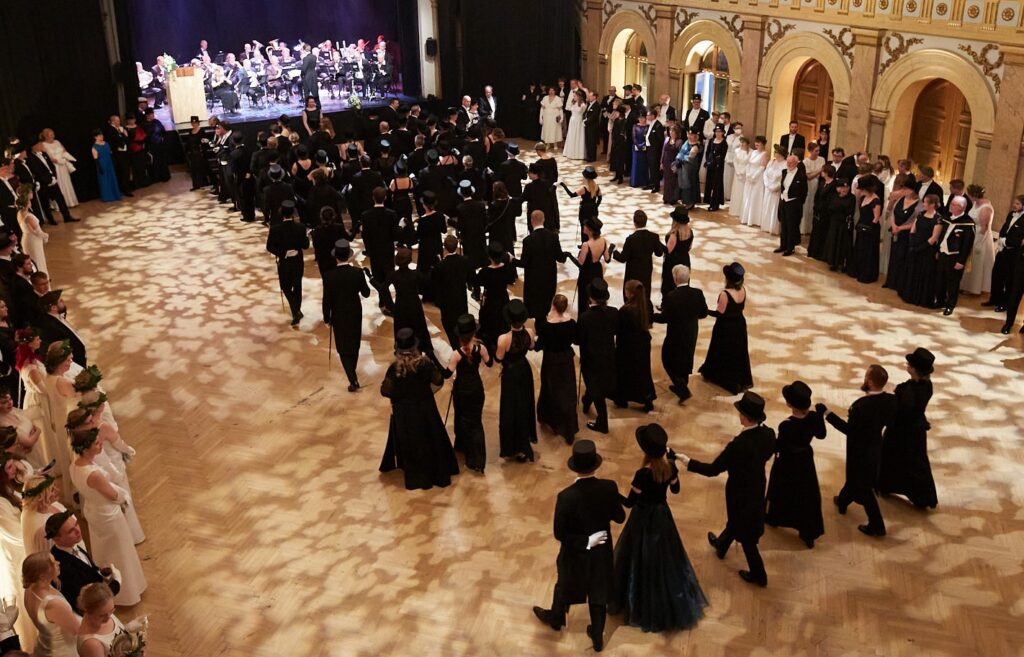
The Excursion
A Finnish student cap is used (if you have one) both indoors and outdoors during the Excursion, so the rest of the outfit should go together with the cap. The outfit should not be too sporty, and jeans or clothing with advertising are not suitable.
Option 1: Relaxed, weather-appropriate outfit. A suitable outfit for the Excursion is, for example, a comfortable but neat skirt or trousers and a cardigan.
Option 2: Relaxed, weather-appropriate outfit. A suitable outfit for the Excursion is, for example, corduroy or cotton trousers, a cardigan and a dress/collar. Coordinates are also suitable.

Other participants
Jubilee Doctor & their avec
The Jubilee Doctor promovendi and their sword-whetters dress according to the dress code given for the Doctor promovendi.
Jubilee Master promovendi and their wreath-weavers
Jubilee Master promovendi dress according to the dress code given to the Doctor promovendi but replace the Doctor’s hat and sword with a laurel wreath and the Master’s ring. The wreath-weavers of the Jubilee Masters dress according to the dress code given to the sword-whetters of the Doctor promovendi.
Guests
Guests dress according to the dress code given for the sword-whetters of the Doctor promovendi. However, guests do not wear gloves during the Conferment Act. Guests participating in the Conferment Act in the Great Hall can also wear a uniform (more on this later) that is according to their possible official position.
During the Conferment Dinner and Ball those following Option 1 must however dress according to the dress code of the sword-whetting dinner (colourful dress) instead of a black dress.
Other instructions regarding the Dress Code and Etiquette
Orders of merit
On the Sword-Whetting- and Wreath-Weaving Day, and on the Excursion, no orders of merit, civil (or military) decorations or other medals of any kind should be worn.
At the Conferment Act and Dinner, state-awarded decorations and orders of merit may be worn in accordance with the instructions given for the award in question. Those who have been awarded decorations etc. by the Finnish state are obligated to wear them, in their original size (not the miniature models). At the Conferment Ball, state-awarded decorations and orders of merit are worn, but in addition to the full-size versions, the miniature models are also allowed.
Academic decorations and orders of merit as well as ribbons/bands of the student nations or other organisations are not permitted in any of the events during the Conferment Ceremony.
Dress uniforms
Persons entitled to use a (dress) uniform may use it in all events at the Conferment Ceremony. The persons in question must of course obey the usual instructions and rules regarding the use of such uniforms. For the promovendi, the only uniform allowed is that of a priest. For other guests, dress uniforms of e.g. the police, armed services or rescue (fire) departments are allowed. However, the general colour worn by one’s own group should be taken into account: for example, the promovendi and the wreath-weavers, who otherwisedress in white, should not wear a black priestly uniform, especially in the Conferment Act.
Other remarks
Those who will not be participating in the wreath-weaving or sword-whetting dinners or in the rector’s reception, but only in the wreath-weaving or the Conferment Act rehearsal, do not have to wear white tie at these events. Instead of evening tailcoats and white waistcoats, option 2 may wear a dark suit (dark grey, dark blue or black) with a white dress shirt and a low-key, preferably light grey, tie. Instead of a colourful, full-length evening gown, option 1 can wear conservatively or more “formally” styled skirt or pant suits. The dress code for the rector’s reception (a part of the sword-whetting dinner) is the same as for the wreath-weaving and sword-whetting dinners, i.e. formal dress/white tie: an evening tailcoat with a white waistcoat or a full-length evening gown.
Finnish student caps are traditionally worn at the wreath-weaving workshop, where the dress code is otherwise smart casual.
The Conferment Act involves plenty of walking and standing in place, so comfortable shoes that do not squeeze or chafe one’s feet are recommended. Another thing to remember when picking footwear is that everyone’s shoes will be visible as they step up to the parnassus (the raised platform that the promovendi stand on as their rank is conferred on them).
Use of the national dress is not allowed during the Conferment Ceremony. All kinds of fur trimmings are also forbidden. As a courtesy to persons with allergies, strongly scented perfumes, colognes etc. are not allowed in the Conferment Act, as the promovendi have to stand very close to each other for several hours.
Etiquette and common codes of conduct
The Conferment Ceremony should be safe for each and every participant. For this reason, we require participants to follow instructions given for safe events throughout the entire Conferment. In addition, we wish participants to consider the Conferment experience in their own behaviour. This includes, for example, avoiding unnecessary talk or otherwise disturbing behaviour during the speeches and performances.
